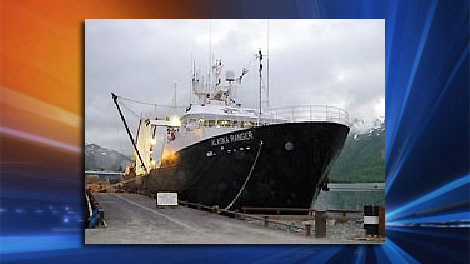SEATTLE - A Coast Guard probe of the 2008 sinking of a fishing vessel in the Bering Sea that killed five people concludes that the vessel's owner failed to properly maintain its structural condition.
However, the report released Wednesday also is highly critical of rules in place at the time covering older fishing boats and how such vessels were being brought into compliance with safety regulations.
Significant changes are needed to prevent more casualties, the report by a Coast Guard Marine Board of Investigation says, adding that current standards are not commensurate with risk.
The 189-foot Alaska Ranger sank March 23, 2008, about 130 miles west of Dutch Harbor, Alaska. Five of the boat's 47 crew members -- including the captain, chief engineer and mate -- were among the dead. The vessel lies under 6,000 feet of water and has never been examined by safety officials.
Without sufficient enforcement of existing requirements, better statutory definitions, more comprehensive safety regulations and periodic inspections, safety for the men and women working aboard fishing industry vessels will continue to be jeopardized, the report by the Coast Guard Marine Board of Investigation says. Changes must be pursued immediately before additional lives are lost and another chapter is added to the 'tragedy of missed opportunities. '
The report concludes the Alaska Ranger's owner, Seattle-based Fishing Company of Alaska, failed to properly maintain the structural integrity of the boat and should have better investigated why fractures were repeatedly found in some structural members. Though exactly what caused the flooding is unknown, it was likely related to the poor material condition of the vessel, the report says.
A representative of FCA did not immediately return a telephone call from The Associated Press.
Bill Jacobsen, brother of Capt. Eric Peter Jacobsen, who died in the sinking, said he came to Wednesday's news conference to tell Coast Guard officials he appreciated their taking time to examine all factors.
There's a lot of things that contribute to problems, not just one thing, said Jacobsen, himself a retired tugboat captain.
The board made 36 recommendations, many technical in nature. However, it was especially critical of the Alternate Compliance and Safety Agreement, a voluntary process aimed at bringing older boats such as the 35-year-old Alaska Ranger into compliance with more stringent safety regulations.
The board recommended the program be scrapped. Rear Adm. Thomas Atkins, the Coast Guard's marine safety leader, acknowledged the program had significant shortcomings, but instead chose to make a variety of improvements and require strict adherence to requirements, said Capt. John P. Nadeau, leader of the board.
The Coast Guard only had about 18 months to put the program into effect, said board member Cmdr. Christopher J. Woodley, and those assigned to it were overwhelmed by trying to cover a fleet of 64 vessels. Since then, he said, the program has been given more staff and resources, and deals with a smaller fleet.
The board also said the Coast Guard should thoroughly enforce all existing commercial fishing regulations, minimize exemptions, and ask Congress to let it expand inspections. Atkins agreed, saying he would work off a law signed by President Barack Obama in October stiffening safety rules, including requiring dockside safety checks of fishing boats at least once every two years.
The report says FCA has a good reputation for safety practices aboard its fleet. Along with the heroism of the Coast Guard crews and others that responded to the emergency, it praised the Alaska Ranger's crew for their calmness and performance during a chaotic evacuation in a storm with 30-foot seas.
Jacobsen said his brother always looked at other people's safety before his own.
The Alaska Ranger used trawler nets to catch mackerel and other fish that were then processed on board. The boat lost power after it began flooding on Easter Sunday and went into reverse, which made evacuation more difficult. Although they had survival suits, only 22 crew members made it into life rafts.
The incident led the Coast Guard to warn ship owners about controllable-pitch propellers, which are used on hundreds of vessels and allow the angle of the propeller blades to be adjusted to improve efficiency.
In 2009, the National Transportation Safety Board determined that the boat most likely sank because the hull was breached when the rudder fell off, leading to uncontrolled flooding. The Coast Guard disagreed, saying it was unlikely the rudder was physically lost and a more probable scenario was that struts attaching the propeller assemblies gave way where they attached to the hull.


